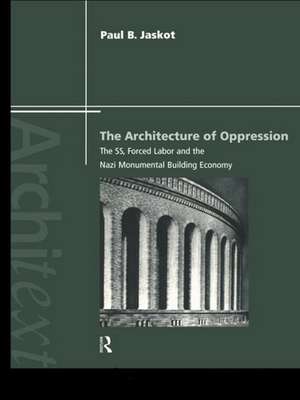The Architecture of Oppression: The SS, Forced Labor and the Nazi Monumental Building Economy: Architext
Autor Paul B. Jaskoten Limba Engleză Paperback – 11 noi 1999
| Toate formatele și edițiile | Preț | Express |
|---|---|---|
| Paperback (1) | 428.28 lei 6-8 săpt. | |
| Taylor & Francis – 11 noi 1999 | 428.28 lei 6-8 săpt. | |
| Hardback (1) | 1005.67 lei 6-8 săpt. | |
| Taylor & Francis – 25 noi 1999 | 1005.67 lei 6-8 săpt. |
Din seria Architext
-
 Preț: 296.00 lei
Preț: 296.00 lei -
 Preț: 303.84 lei
Preț: 303.84 lei - 16%
 Preț: 261.73 lei
Preț: 261.73 lei -
 Preț: 424.16 lei
Preț: 424.16 lei - 17%
 Preț: 233.42 lei
Preț: 233.42 lei - 18%
 Preț: 275.26 lei
Preț: 275.26 lei - 28%
 Preț: 991.00 lei
Preț: 991.00 lei - 15%
 Preț: 328.84 lei
Preț: 328.84 lei - 24%
 Preț: 360.80 lei
Preț: 360.80 lei - 24%
 Preț: 356.24 lei
Preț: 356.24 lei - 12%
 Preț: 331.51 lei
Preț: 331.51 lei - 12%
 Preț: 299.67 lei
Preț: 299.67 lei - 22%
 Preț: 373.74 lei
Preț: 373.74 lei - 19%
 Preț: 271.58 lei
Preț: 271.58 lei - 17%
 Preț: 240.48 lei
Preț: 240.48 lei -
 Preț: 347.91 lei
Preț: 347.91 lei - 25%
 Preț: 428.37 lei
Preț: 428.37 lei - 30%
 Preț: 770.74 lei
Preț: 770.74 lei - 15%
 Preț: 458.41 lei
Preț: 458.41 lei - 16%
 Preț: 262.55 lei
Preț: 262.55 lei - 26%
 Preț: 991.00 lei
Preț: 991.00 lei - 18%
 Preț: 1071.63 lei
Preț: 1071.63 lei - 25%
 Preț: 429.08 lei
Preț: 429.08 lei - 14%
 Preț: 314.06 lei
Preț: 314.06 lei - 30%
 Preț: 769.92 lei
Preț: 769.92 lei - 24%
 Preț: 431.66 lei
Preț: 431.66 lei - 24%
 Preț: 324.59 lei
Preț: 324.59 lei - 23%
 Preț: 331.19 lei
Preț: 331.19 lei -
 Preț: 450.99 lei
Preț: 450.99 lei
Preț: 428.28 lei
Preț vechi: 552.83 lei
-23% Nou
Puncte Express: 642
Preț estimativ în valută:
81.98€ • 89.08$ • 68.91£
81.98€ • 89.08$ • 68.91£
Carte tipărită la comandă
Livrare economică 21 aprilie-05 mai
Preluare comenzi: 021 569.72.76
Specificații
ISBN-13: 9780415223416
ISBN-10: 0415223415
Pagini: 224
Dimensiuni: 178 x 254 x 14 mm
Greutate: 0.48 kg
Ediția:1
Editura: Taylor & Francis
Colecția Routledge
Seria Architext
Locul publicării:Oxford, United Kingdom
ISBN-10: 0415223415
Pagini: 224
Dimensiuni: 178 x 254 x 14 mm
Greutate: 0.48 kg
Ediția:1
Editura: Taylor & Francis
Colecția Routledge
Seria Architext
Locul publicării:Oxford, United Kingdom
Public țintă
General and UndergraduateCuprins
List of Illustrations. Acknowledgments. Abbreviations. 1. Introduction: The Architectural Policy of the SS. 2. The Interest of the SS in the Monumental Building Economy. 3. The Party Rally Grounds at Nuremberg: SS Economic Goals and National Socialist Architectural Policy. 4. The Rebuilding of Berlin: The Interdependence of the GBI and the SS. 5. The Political Function of SS Architecture.6.Conclusion. Notes. Bibliography. Index.
Notă biografică
Paul B. Jaskot is Assistant Professor in the department of Art and Art History at DePaul University in Chicago. His work focuses on the relationship between culture and politics in modern European Art and Architecture.
Recenzii
'Paul Jaskot's book is a welcome injection of life into what had become a stale debate.' - Building Design, April 20, 2000
'It does cast a significant new light on attempts to strip Nazi architecture of its political and moral associations.' - Building Design, April 20, 2000
'Jaskot's attention to actions rather than motives, and to quarries rather than aesthetics, gives precision and weight to his argument about the importance placed upon monumental architecture in Nazi Germany,' - Harvard Design Magazine
'This book is the result of painstaking research ... Jaskot has put another nail in the coffin of Leon Krier's extraordinary attempt to exonerate the Nazi monuments by removing them from their political context.' - The Architectural Review
'The Architecture of Oppression could become a prime reference for the issues of art, architecture, and urban design, and the role of politics in general and the Nazis in particular.' - Town Planning Review
'An invaluable understanding of the politics of architecture, one that complements and enhances those investigations to Nazi architecture's expression, ideological function with which we are already familiar.' - Oxford Art Journal
'An important contribution shedding light upon the manifold interrelations between politics, architecture and the economy of the camp system.' - Planning Perspectives, 17 February 2002
'It does cast a significant new light on attempts to strip Nazi architecture of its political and moral associations.' - Building Design, April 20, 2000
'Jaskot's attention to actions rather than motives, and to quarries rather than aesthetics, gives precision and weight to his argument about the importance placed upon monumental architecture in Nazi Germany,' - Harvard Design Magazine
'This book is the result of painstaking research ... Jaskot has put another nail in the coffin of Leon Krier's extraordinary attempt to exonerate the Nazi monuments by removing them from their political context.' - The Architectural Review
'The Architecture of Oppression could become a prime reference for the issues of art, architecture, and urban design, and the role of politics in general and the Nazis in particular.' - Town Planning Review
'An invaluable understanding of the politics of architecture, one that complements and enhances those investigations to Nazi architecture's expression, ideological function with which we are already familiar.' - Oxford Art Journal
'An important contribution shedding light upon the manifold interrelations between politics, architecture and the economy of the camp system.' - Planning Perspectives, 17 February 2002
Descriere
This book re-evaluates the architectural history of Nazi Germany and looks at the development of the forced-labour concentration camp system.


















